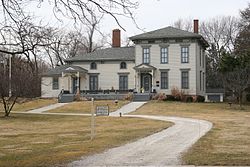Norwood Park | |
|---|---|
| Community Area 10 - Norwood Park | |
 The Noble–Seymour–Crippen House,a Chicago Landmark, at 5624 N Newark Ave. | |
 Location within the city of Chicago | |
| Coordinates: 41°58.8′N 87°48.0′W / 41.9800°N 87.8000°W | |
| Country | United States |
| State | Illinois |
| County | Cook |
| Townships | City of Chicago Norwood Park |
| City | Chicago |
| Neighborhoods | list
|
| Area | |
• Total | 4.29 sq mi (11.11 km2) |
| Population (2020) | |
• Total | 38,303 |
| • Density | 8,900/sq mi (3,400/km2) |
| Demographics 2015[1] | |
| • White | 80.83% |
| • Black | 0.92% |
| • Hispanic | 11.85% |
| • Asian | 4.19% |
| • Other | 2.21% |
| Educational Attainment 2015[1] | |
| • High School Diploma or Higher | 92.2% |
| • Bachelor's Degree or Higher | 35.2% |
| Time zone | UTC-6 (CST) |
| • Summer (DST) | UTC-5 (CDT) |
| ZIP Codes | parts of 60631, 60646, 60656 |
| Median household income | $71,282[1] |
| Source: U.S. Census, Record Information Services | |
Norwood Park is one of the 77 Chicago community areas. It encompasses the smaller neighborhoods of Big Oaks, Norwood Park East, Norwood Park West, Old Norwood Park, Oriole Park, and Union Ridge.
The community area contains the oldest extant building in Chicago, the Noble–Seymour–Crippen House, built in 1833 and greatly expanded in 1868.[2] Organized in 1873 as a township from the adjacent townships of Jefferson, Leyden, Niles, and Maine,[3] and named after Henry Ward Beecher's 1868 novel Norwood, or Village Life in New England (With the "Park" added to account for another post office in Illinois with the Norwood name), Norwood Park was incorporated as a village in 1874[4] and annexed to Chicago on November 7, 1893.[5]
Every Memorial Day since 1922 there has been a parade that runs through Norwood Park.[6] William Howard Taft High School, best known as the inspiration for the musical Grease, was completed in 1939 with major additions made in 1959 and 1974.
- ^ a b c "Community Data Snapshot - Norwood Park" (PDF). MetroPulse. Retrieved April 13, 2017.
- ^ "History of the Noble-Seymour-Crippen house". Norwood Park Historical Society. Retrieved 21 August 2018.
- ^ "About the neighborhood of Norwood Park". Norwood Park Historical Society. Retrieved 22 August 2018.
- ^ "Norwood Park". www.encyclopedia.chicagohistory.org. Retrieved 23 April 2018.
- ^ https://chicagology.com/wp-content/themes/revolution-20/chicagoimages/annexation1930.jpg [bare URL image file]
- ^ "Memorial Day Parade". Norwood Park Chamber of Commerce & Industry. Retrieved 21 August 2018.